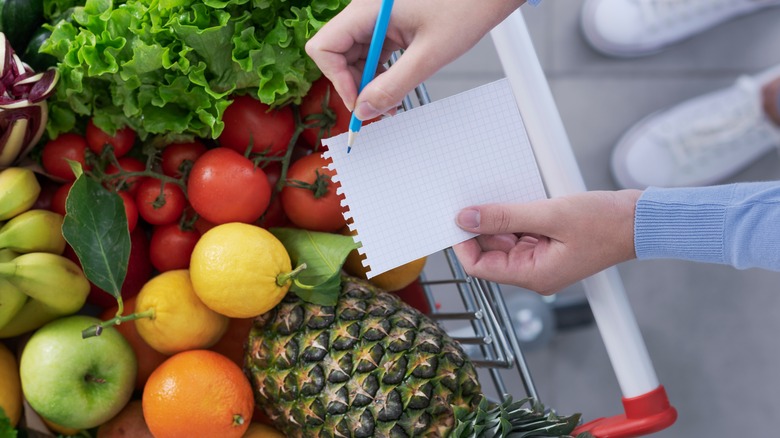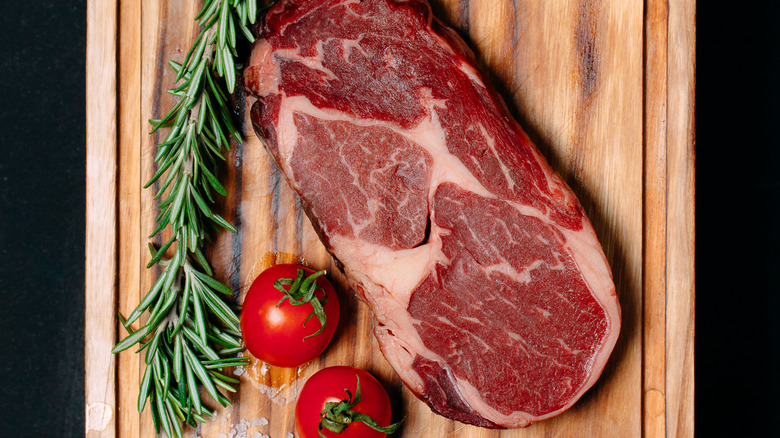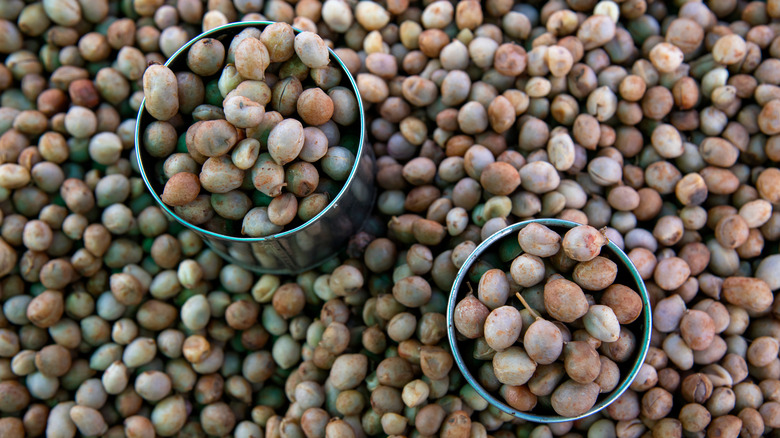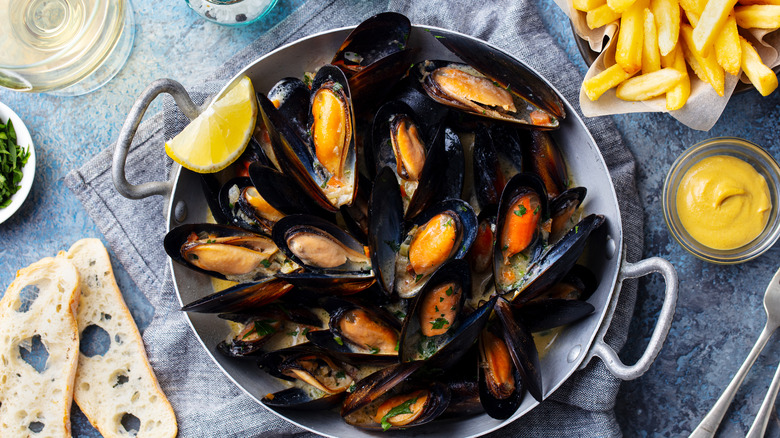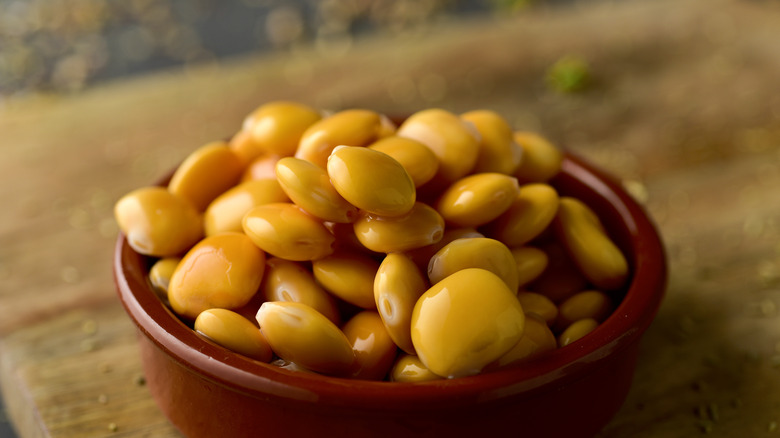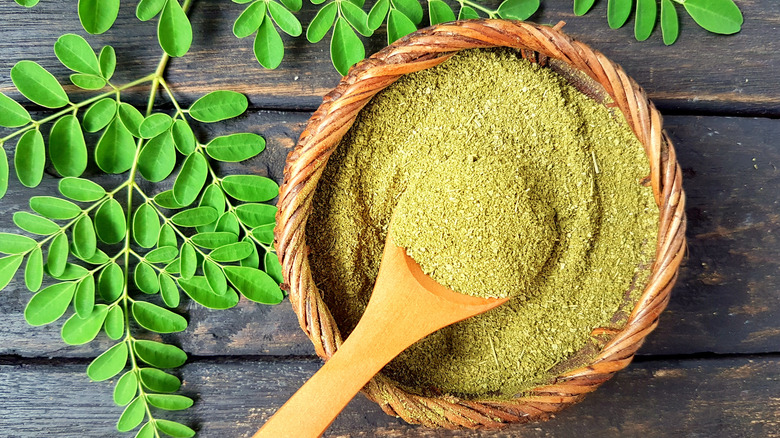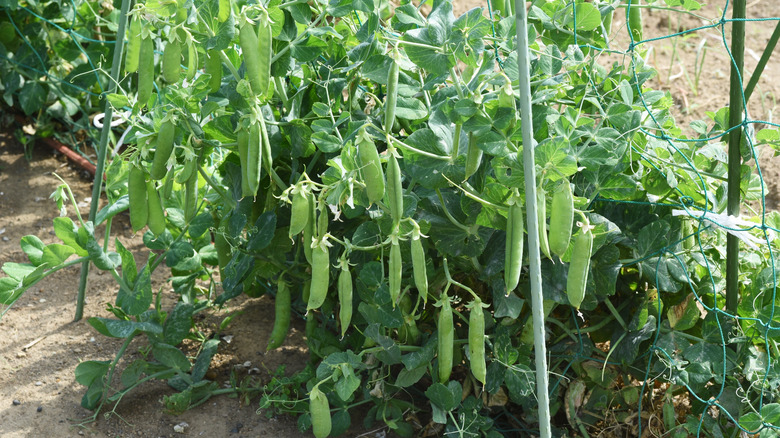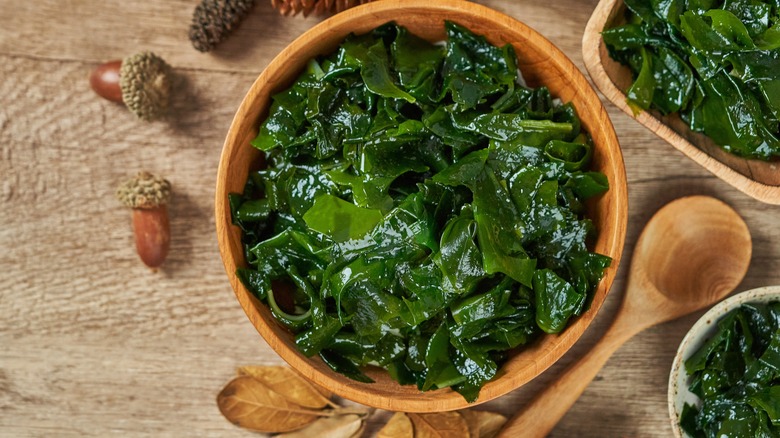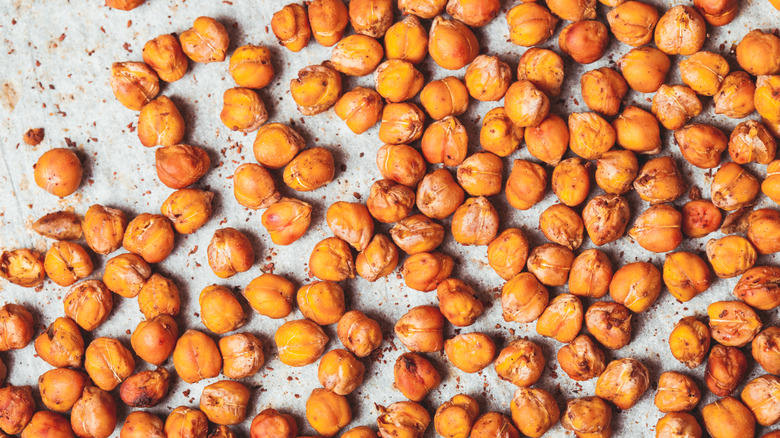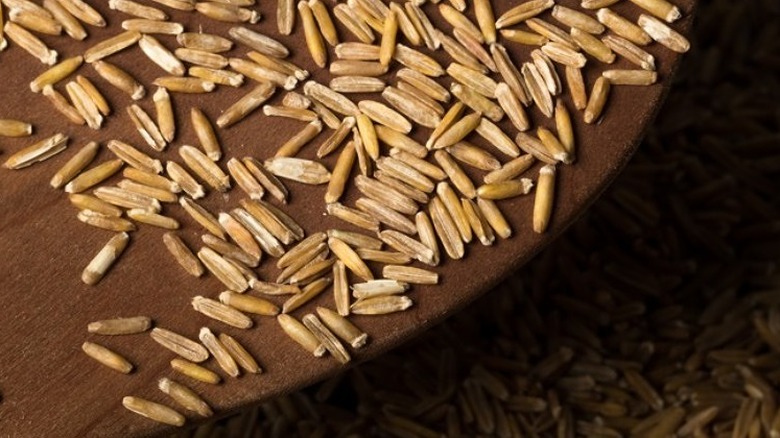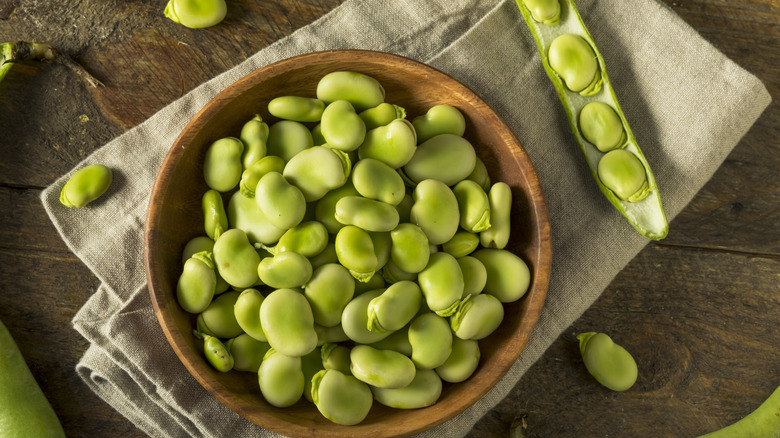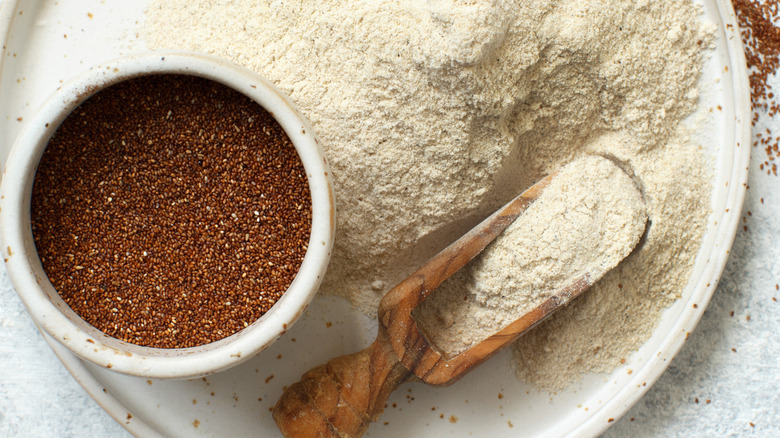11 Foods That Will Fit Your Regenivore Diet
With the rising cost of groceries and a rapidly changing climate that's both affecting and being affected by methods of food production, the typical well-intended resolution of dietary changes comes loaded with extra urgency this year. Shifting how we eat is no longer an action with solely individual benefits — not that it ever really was. Instead, using our eating habits as tools of collective action in the face of climate change is more than just a good option, it's imperative. So much so that The New York Times recently named the regenivore diet as a driving food trend of the future.
But, what does it mean to be a regenivore, and what does it look like? A regenivore is someone who eats a diet centering the products of regenerative agricultural systems. Per Natural Resources Defense Council, regenerative agriculture is a philosophy of land management that considers farming on a holistic approach. Regenerative agriculture has long been practiced by Indigenous populations. In this system, the end results — meaning the grass that's grown, the foodstuff that is harvested, the livestock that's raised — return healthy impacts back to the environment. Nitrogen is fixed in the soil, healthy microbial life blossoms, carbon is sequestered, and rainwater is preserved.
As living beings on an eroding Earth, every time we open our mouths to feed ourselves we are making an environmental choice. By adding or substituting these foods to our diet, we can align ourselves with regenivore principles that go beyond sustainability towards a healthier, restored planet.
1. Bison meat
Conventional wisdom does more than suggest that too much red meat is bad for the planet. The amount of water it takes to produce a pound of beef is around 2,000 gallons. Per a Harvard University estimate that averages a rate of 20 gallons for 8 minutes of washing, we're basically trading 100 showers every time we eat 16 ounces of steak, burgers, or ribs. That massive amount is not the same for all kinds of beef; cattle raised in a free-roaming pasture have a "greener" water footprint. Water usage becomes lighter for grazing animals, like the rambling, semi-domesticated bison.
Unlike their cousin cows, bison herds prefer large areas of land to roam. As researchers at Colorado's Savory Institute told 9News Colorado, bison have coevolved with grasslands. It's a cyclical relationship; bison droppings fertilize the soil while their hooves churn it enough to allow rainwater to permeate topsoil, reducing water loss without disrupting soil structure. Similarly, the food which bison graze on — perennial grass — is known to pull carbon from the atmosphere and lock nitrogen in the soil. Decreasing evaporation and increasing carbon sequestration is highly regenerative.
In our opinion, bison meat also just tastes better. Despite a leaner composition that comes from a life on the move (bison meat has fewer calories with more protein), it has the same rich minerality that is highly sought after in grass-fed cattle. It's often sold in familiar cuts (rib-eye, New York strips, and filets), but finding ground bison is your best bet.
2. Bambara nuts
Carbon emissions get all of the attention, but as the United Nations Environment Program reports, nitrogen and nitrous oxide play an outsized role on the greenhouse effect as well. Human agriculture, specifically synthetic fertilizers, is a major source of nitrogen release. Yet nitrogen isn't all bad, so long as it's stored where it belongs; despite creating a warming effect in the atmosphere, farmers add nitrogen to soil because plants need it.
Some plants, however, actually thrive in nitrogen-degraded soils. These "soil remediators" function in a way that pulls nitrogen from the air and stores it in the earth, replenishing the quality and fertility of dirt in the process. Studies have shown that small, darkly colored nuts called Bambaras are successful at this (via Eco-Business News).
Bambara is a ground nut grown in West African countries like Ghana, though it isn't even widely known on the continent. Bamabara nuts have long been a sustenance crop for poor farmers rather than a source of income. Given its dense nutrient profile and regenerative environmental impacts, Bambara nuts are a dream component for regenivore diets. The flavor is similar to peanuts, with less oil and a touch more sweetness. Companies like WhatIF produce plant milk and noodle packages from this nut, but certain specialty outlets also sell them in bulk, too. Commonly, Bambara nuts are dried, roasted, or boiled and used as a snack, porridge filler, or flour. Bambara can be turned into hummus, bean salad, or a savory Nigerian pudding called okpa wawa.
3. Mussels
Nature's processes don't occur in a vacuum. Similarly, environmental degradation isn't just occurring on land, but at sea and in bodies of fresh water, too. Some of this is from direct pollution, such as waste dumping, but other impacts occur secondhand. Nitrogen isn't only a problem in our atmosphere; fertilizer runoff from agriculture operations leads to streams, rivers, bays, and lakes that are devoid of nutrients (via the BBC). In a process called eutrophication, organisms like algae feed on elements like phosphorus and nitrogen, "bloom" in large colonies, reduce dissolved oxygen in the water, block sunlight, and corrupt healthy ecosystems.
Bivalves, or filter feeders, provide an important service to aquatic environments. As Montgomery County Maryland details, mussels have two openings in their shells — one to pull in water and one to expel it. In the process, these creatures create clean conditions and improve water quality by feeding on algae and bacteria. As a long-lived species, they benefit the extended health of waterways. Raising mussels requires little to no inputs, and per BBC reporting, replacing 25% of carnivorous fish aquaculture (like farm-grown salmon) with bivalve production can significantly reduce carbon emissions.
Mussels are also delicious. They're mildly briny in flavor with a dense, meaty texture that can fill out an appetizer or make a substantial main. Freshly harvested mussels are seasonal and more regularly available in the summer. However, grocery stores commonly sell frozen mussels in both shelled and de-shelled options. This garlic mussel recipe is your new regenivore staple.
4. Lupini beans
Take a trip to Spain, Portugal, or Italy, and you'll find that lupini beans are as common as a sunny day. Often provided as a bar snack or an accouterment on antipasto boards, some folks — like the company BRAMI — have even claimed that they sustained Roman soldiers (via Forbes). Whether its history as a classical powerhouse is fact or fiction, one thing is verifiably true: Lupini beans have the power to build strong bodies while offering agriculturally restorative benefits.
Lupini beans have the type of nutrient profile that earns the reputation of a "superfood." One cup can have up to 26 grams of plant-based protein while containing nine essential amino acids (via The Beet). And, they're loaded with dietary fiber, complex B vitamins, minerals, and vitamin C. Studies in the journal Nutrients have revealed Mexican varieties to be high in anti-cancerous phytochemicals, while the National Library of Medicine suggests insulin-managing properties. Because of a naturally bitter taste, lupini beans are often brined. The best way to add them to any diet is as a snack, salad topper, or through one of the many prepared products on the market. Companies now make vegan protein, pasta, flour, and egg alternatives from lupini beans.
As legumes, lupinis have nitrogen-fixing properties (via Frontiers in Plant Science). Being annual plants, however, they have higher turnover than perennials and thus have shorter-term effects. Still, by supplementing your protein needs with lupini, more nitrogen-fixing, plant-protein crops will go into rotation, a strategy currently being studied in Europe.
5. Moringa
Moringa is a miraculous plant. The benefits of its growth seem to stretch in every direction. The plant's growth provides regenerative benefits to the soil and air; growing it raises economic opportunities; it's a nutrient-dense food that is used for medicinal purposes. Also called the horseradish or drumstick tree, moringa is a deciduous plant indigenous to tropical Asia. It's consumed in a number of ways, with moringa powder being the most accessible.
Young moringa leaves are loaded with minerals, including thick concentrations of iron, potassium, and vitamin C. You can combine them with stews, soups, or braises. While slightly bitter, the addition of acid or something sweet is all you need to balance out the flavor in the same way you would when cooking kale or chard. Another way to eat moringa is by the pods. Fresh ones aren't easy to find, but international grocery stores often stock pre-cut, frozen moringa pods that can be utilized in place of green beans or okra. Finally, moringa powder is one food you might consider adding to your regenivore diet. It can be added to virtually anything, from yogurts to smoothies, soups, sauces, or dressings.
Anti-oxidative and potentially impactful on high blood pressure and inflammation, moringa's nutrient-rich nature is just as healthy for Earth. The benefits of moringa start from the roots, which are drought-resistant and can reduce topsoil erosion. Studies show that moringa is also successful at sequestering carbon emissions (via the International Journal for Scientific Research & Development).
6. Peas
For such a simple green ingredient, peas can incite some very strong opinions. Whatever your take, you can't hate on what peas bring to the table in terms of environmental impact. Another member of the legume family, Texas A&M University reports that varieties like sugar snap peas have a high propensity for nitrogen-fixing. But not only does this crop pull nitrogen from the air and stash it into the dirt, but they actually feed off of it as well. As a rotational crop, peas thus improve the soil health of wherever they're planted.
As food company PURIS has found out, peas are actually a very good first step toward bringing regenerative farming strategies to the mainstream. The company cites market pressures as the greatest reason why farmers don't quickly adopt methods of agriculture that would replenish the soil — which is very depressing when you stop to consider the relation between money and crucial climate-saving measures. That said, the regenivore diet is made to eat with impact, and substituting peas to your diet in any form will send a small signal that this is a profitable crop. And so we say: Bring on the peas!
And oh, are they ever. Beyond fresh, frozen, and canned peas that you can cook with, the food market has exploded with products offering protein-packed peas as the primary piece. Peas are in your favorite plant-based meat, can be drunk as keto-friendly milk alternatives, and in dried packages as salty, snappy snacks.
7. Kelp
Kelp is a type of seaweed widely known for its environmental benefits. Kelp's primary asset is its ability to absorb large amounts of carbon dioxide, which can reduce the amount of greenhouse gases in the environment, thus offering restorative effects in regard to climate change (via The Atlantic). Kelp forests, which grow at an astonishing two feet per day (thanks to carbon capture), also reduce coastal erosion. Additionally, kelp can be used as a sustainable source of biofuel, which can help to reduce our dependence on fossil fuels. Kelp isn't only a restorative superstar — it's also a regenerative food to include within your diet.
Kelp is an exceptional way for vegetarians and vegans to add seafood to their plates — and one that's full of nutrients, per the Seafood Nutrition Partnership. Magnesium, iron, omega-3s, and various vitamins can all be sourced from kelp. Research in the journal of Food Chemistry has shown that a natural fiber in kelp called alginate can even block the uptake of unhealthy fats within your gut and microbiome, plus the naturally heightened levels of iodine are exceptionally beneficial for hormone balance (via Healthline).
Including the briny, grassy flavor of kelp in your diet is simple. Kelp powders and supplements can be found at wellness stores and large supermarkets. Plus, the popularity of kelp has opened a slew of prepared food options — from fresh-frozen kelp for cooking in soups, stews, and salads to pre-jarred "Sea-Chi," a riff of seaweed kimchi from Atlantic Sea Farms.
8. Chickpeas
Adding environmentally regenerative foods to your diet doesn't always have to mean transitioning to new, unknown ingredients. The humble and common chickpea, aka garbanzo bean, is part of the legume family. As such, they have replenishing effects on the local environment in which they are grown. Per Frontiers in Plant Science, Legumes are a nitrogen-fixing crop, meaning that they can improve dirt health by adding nitrogen to the soil rather than requiring synthetic or even natural nitrogen fertilizer additions that can escape and become greenhouse gasses. And while they don't exactly add water back into the natural world, chickpeas are drought-resistant, requiring less water than many other types of crops and making them well-suited for dry or arid regions.
Chances are that you're already familiar with this wonder ingredient, whether you're cooking dried or canned chickpeas. However, in case you aren't, chickpeas have a plain taste that can sometimes veer into mildly nutty, earthy territory. The beautiful thing about garbanzos as an ingredient is that they provide neutrality to your dish and may even take on a slight accent from strong ingredients like garlic or lemon. Spiced or salted chickpeas provide a texturally stunning snack or salad topper when roasted, whipped chickpeas are better known in their famous form of hummus, and there are too many brands to count in the market these days currently making chickpea alternatives for milk, pasta, flour, and other prepared goods. And there should be! Garbanzos are loaded with plant-based protein and crucial nutrients all while being inexpensive (via Healthline).
9. Kernza grain
Kernza is a grain harvested from a relative of wheatgrass, called intermediate wheatgrass. Historically, this grass has been used for livestock grazing, pastureland, and erosion control across the United States and Canada. However, research-based organizations like The Land Institute have spent the last couple of decades discovering how to use Kernza grain for human food. A trademark has even been placed on the grain to ensure what consumers are buying is the real thing.
Kernza is a revolutionary grain. As a perennial seed, it regrows and reproduces every season, unlike traditional wheat which, as an annual, is sown, grown, harvested, and cut every year. Annual grains leave the soil vulnerable to erosion and nutrient runoff, which as we've noted can be detrimental to other biomes along with depleting topsoil (via Albert Lea Seed). Instead, Kernza requires less nitrogen fertilizer than annuals and works to trap potential greenhouse gases within the soil. Kernza's deep roots, which go more than 10 feet, draw down carbon from the air to build healthy soil, improve wildlife habitat, and protect water resources.
Lucky for us, Kernza tastes great too. This grain has a unique flavor profile that is slightly nutty. It's high in protein and antioxidants, with eight times the insoluble dietary fiber of whole wheat flour, and less gluten than traditional wheat. You can use it as flour, cereal, beer, popped grain, pasta, baked goods, or spirits. Perennial Pantry, a company devoted to perennial foods, currently sells Kernza whole grain and as flour nationwide.
10. Fava beans
Vicia faba, also known as fava beans, horse beans, or broad beans, depending on where you are in the world, is one of the earliest known domesticated crops. Today, they are grown across the globe with the largest producers being China, Ethiopia, Australia, France, and Morocco (via smart protein).
This less starchy, milder-flavored lima bean look-alike is commonly used in dips, soups, stews, and salads. Fava beans are rich in plant-derived protein, fiber, and iron (via Healthline). If you want to find fresh fava beans, you'll want to look out for them at markets in the springtime; however, you can find them dried or canned throughout the year.
On top of their deliciousness, the key to what makes fava beans a top pick for a regenivore's diet is their ability to take nitrogen from the atmosphere and fix it into the soil. This means they're a great cover crop for field rotations, they don't require fossil fuel-derived nitrogenous fertilizer, can grow in nutrient-poor soils, and in turn, give back to the soil for other plants (via the journal of Fields Crop Research). Fava beans are also used in the production of plant-based meat alternatives, which you can purchase in good conscience knowing that your food is helping to draw down detrimental greenhouse gases.
11. Teff
Teff is a type of cereal grain that is grown in Ethiopia and Eritrea. Teff grain is drought-tolerant and requires little water to grow (via Oregon State University). It can do so on marginal lands that are not suitable for other types of crops, per Utah State University, helping to conserve valuable land resources. Regeneratively, teff is considered a rotational plant that can improve soil health, conserve water, and reduce pest and disease pressure and help to build resilience to climate change (via The Lexicon).
Alongside being a strong plant environmentally, teff is highly nutritious. It's a good source of dietary fiber, promoting healthy digestion, and is rich in minerals important for healthy blood cells, immune-system functions, and maintaining healthy bones. If you need other reasons to consider picking up teff, this grain contains the nine essential amino acids that make up a complete protein source for vegetarians, vegans, or meat-light eating schemes. As a naturally gluten-free grain, teff is great for those with any kind of gluten intolerance. Look no further for your next favorite ingredient.
Beyond its basic use as a flour, teff can be used to make porridge, cooked in whole form for grain bowls and salads, or even used as a more nutritious replacement for breakfast cereals. In terms of international cuisines, the most widely known use of teff might be injera, a springy, spongey, fermented-flour flatbread that's a traditional staple of Ethiopian food. This shortcut injera recipe is a great place to start for your regenivore diet.
